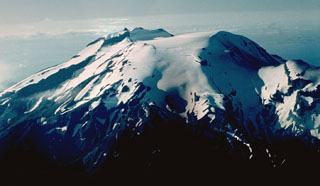Report on Calbuco (Chile) — September 1996
Bulletin of the Global Volcanism Network, vol. 21, no. 9 (September 1996)
Managing Editor: Richard Wunderman.
Calbuco (Chile) Strong fumarolic emission from main crater
Please cite this report as:
Global Volcanism Program, 1996. Report on Calbuco (Chile) (Wunderman, R., ed.). Bulletin of the Global Volcanism Network, 21:9. Smithsonian Institution. https://doi.org/10.5479/si.GVP.BGVN199609-358020
Calbuco
Chile
41.33°S, 72.618°W; summit elev. 1974 m
All times are local (unless otherwise noted)
On the morning of 12 August, the ~250,000 residents of Puerto Montt (35 km SW) and Puerto Varas (36 km SW) were alarmed by strong fumarolic emissions from the 1.5-km-diameter main crater of Calbuco. In May 1995 a weak fumarole was noticed and filmed from a helicopter. Prior to that, Calbuco had showed no signs of activity since a 1972 eruption that lasted for ~4 hours.
Calbuco is a very explosive late Pleistocene to Holocene andesitic volcano S of Lake Llanquihue that underwent edifice collapse in the late Pleistocene, producing a volcanic debris avalanche that reached the lake. One of the largest historical eruptions in southern Chile took place from Calbuco in 1893-1894. Violent eruptions ejected 30-cm bombs to distances of 8 km from the crater, accompanied by voluminous hot lahars. Several days of darkness occurred in San Carlos de Bariloche, Argentina (>100 km SE). Strong explosions occurred in April 1917, and a lava dome formed in the crater accompanied by hot lahars. Another short explosive eruption in January 1929 also included an apparent pyroclastic flow and a lava flow. The last major eruption of Calbuco, in 1961, sent ash columns 12-15 km high and produced plumes that dispersed mainly to the SE as far as Bariloche; two lava flows were also emitted.
Geological Summary. Calbuco is one of the most active volcanoes of the southern Chilean Andes, along with its neighbor, Osorno. The late-Pleistocene to Holocene andesitic volcano is immediately SE of Lake Llanquihué in the Chilean lake district. Guanahuca, Guenauca, Huanauca, and Huanaque, all listed as synonyms of Calbuco (Catalog of Active Volcanoes of the World), are actually synonyms of nearby Osorno volcano (Moreno 1985, pers. comm.). The edifice is elongated in a SW-NE direction and is capped by a 400-500 m wide summit crater. The complex evolution included collapse of an intermediate edifice during the late Pleistocene that produced a 3-km3 debris avalanche that reached the lake. It has erupted frequently during the Holocene, and one of the largest historical eruptions in southern Chile took place from Calbuco in 1893-1894 that concluded with lava dome emplacement. Subsequent eruptions have enlarged the lava-dome complex in the summit crater.
Information Contacts: Hugo Moreno, Observatorio Volcanologico de los Andes del Sur (OVDAS), Universidad de la Frontera, Casilla 54-D, Temuco, Chile.

